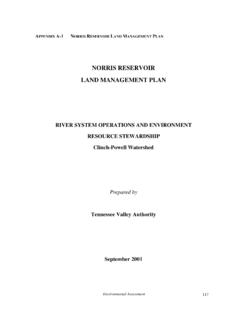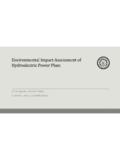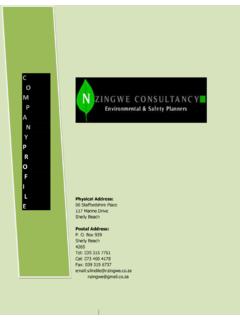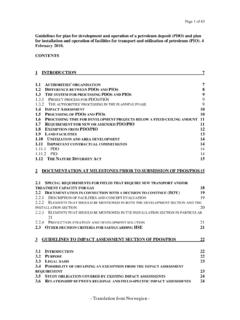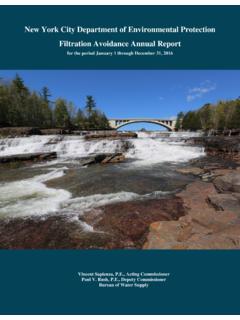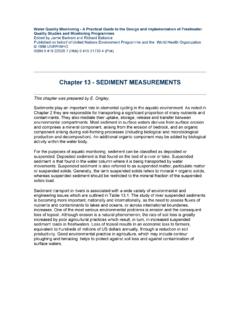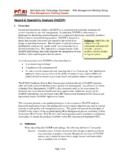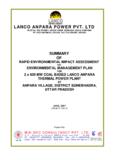Transcription of Testimony of Vincent Sapienza, P.E. Acting …
1 Testimony of Vincent Sapienza, Acting Commissioner, New york city Department of environmental Protection before the New york city Council Committee on environmental Protection concerning the FY 2018 Preliminary Budget Committee Room city Hall Thursday, March 23, 2017, 10:00 am Good morning Chairman Constantinides and Members. I am Vincent Sapienza, Acting Commissioner of the New york city Department of environmental Protection (DEP). I am joined today by Chief Financial Officer Joseph Murin, Deputy Commissioner for Public Affairs Eric Landau, as well as other senior managers. Thank you for the opportunity to testify on DEP's Fiscal Year 2018 Preliminary Budget. As you very well know, DEP has overall responsibility for the city 's water supply and sewer system, including providing drinking water to all New Yorkers, maintaining pressure to fire hydrants, managing storm water, and collecting and treating wastewater. In addition, DEP also regulates air quality, hazardous waste, and critical quality of life issues, including noise.
2 All of our water-related expenses both operational and capital are paid for with the money collected from the water and sewer rate charge billed to all New york city property owners and authorized annually by the New york city Water Board. In May 2016, the NYC Water Board adopted a rate package that included: - increase, the lowest increase in 16 years - freezing of the minimum charge of $ per day for the third consecutive year, which benefits more than 150,000 customers who use fewer than 100 gallons of water per day - expanding of the Home Water Assistance Program to any property owner who makes less than $50,000 per year, providing a $118 credit - creating the Multi-family Affordable Housing Credit, which would provide a $250 credit to any residential property that signs, at a minimum, a fifteen-year affordability agreement with NYC Housing Preservation and Development or the NYC Housing Development Corporation Additionally, as part of last year's budget, Mayor de Blasio fully eliminated the rental payment, five years sooner than originally projected.
3 As part of the FY 17 Water Rate, the NYC Water Board adopted a one-time credit of $183 to all Tax Class 1 properties, which includes 1-, 2-, and 3-family homeowners. As you all know, the FY 17 Water Rate and $183 credit were challenged by the Rent Stabilization Association. Based on an original ruling from the NYS Supreme Court, as well as a subsequent ruling from the Appellate Division, First Department, we are currently unable to implement the FY 17 rate, associated program expansions, and the $183 credit. The Water Board is seeking leave to appeal this decision, and we will be sure to keep you all apprised of that process. The Water Board is also in the process of determining how it will proceed this spring with setting rates for FY 2018 and we will be sure to keep you updated. Before I get to the substance of my Testimony today, I want to briefly touch on the quality of New york city 's drinking water. Water quality in Flint, Michigan, Hoosick Falls, and Newburgh continue to be covered widely in the news.
4 Much has been made of late about elevated lead levels in some NYC school fixtures (fountains, sinks, etc.). I want all New Yorkers to rest assured that New york city 's drinking water is of the highest quality and the water delivered from the upstate reservoir system is lead free. We spend substantial time and resources testing the water quality from 1,000 water quality testing locations around the five boroughs, as well as testing water quality upstate in our reservoirs, lakes, and tunnels. In total, DEP conducts over 600,000 water quality tests every year. The Department of Education is currently completing citywide testing of all water fixtures in city schools. Any drinking or cooking water fixture with results over 15 parts per billion is immediately taken offline and remediated. Again, while New york city 's water is lead-free when it is delivered from our reservoir system, water can absorb lead from pipes, fixtures, and solder (material used to join pipes) found in the plumbing of some buildings or homes.
5 To help reduce the risk that lead can dissolve from a homeowner's plumbing/service line into their tap water, DEP carefully monitors pH levels (a measure of acidity/alkalinity) of the water and adds phosphoric acid, which creates a protective film, reducing the release of metals from household plumbing. Property owners interested in testing their water for lead can contact DEP for a free lead kit by calling 311. Upon receiving the water sample, DEP will test the water and send the property owner the results within 30 days. Should the results show an elevated level, DEP shares the results with the Department of Health and Mental Hygiene, and the city will inform the property owner of some recommended next steps. Key Accomplishments and Updates Let me start by providing some context to our capital and expense budgets, including some recent accomplishments, updates on our initiatives as part of OneNYC, a brief overview of a number of performance metrics, and an update on key programs and projects.
6 This past year we: - completed a $1 billion project to upgrade four wastewater treatment plants and reduce nitrogen discharges into local harbor waterways by 60%. - completed construction and activated a $260 million water tunnel connecting Brooklyn and Staten Island, creating additional redundancy - began a $132 million sewer upgrade project in College Point, Queens, to mitigate street flooding and improve harbor water quality of Flushing Bay - began a $34 million dredging project in Flushing Bay - began a $ million project in Canarsie, Brooklyn, to reduce flooding and upgrade water mains 2. - opened an additional 2,600 acres for recreation in the watershed more than 133,000 acres are now open for fishing, hiking and other low-impact recreation - reauthorized the lien sale with the strong support of the city Council, the Department of Finance, and Housing Preservation & Development, providing DEP the ability to sell liens on delinquent water rate payers, ensuring that everyone who benefits from our water and wastewater systems pays their fair share, as well as helping us keep water rates as low as possible.
7 Update on OneNYC. Playing a major role in our activities is Mayor de Blasio's OneNYC plan, released on April 22, 2014. OneNYC includes several initiatives that DEP is hard at work on, including: - protecting the city 's water supply and maintaining the reliability and resiliency of the water supply system - installing or repairing 500 water fountains and water bottle refilling stations across the five boroughs - expanding green infrastructure and diversifying techniques for stormwater management in neighborhoods across the city - reducing pollution from stormwater runoff To meet the city 's water supply needs, New york city has a robust water-supply infrastructure investment program, including projects such as a new tunnel to bring water from Kensico Reservoir to the Catskill/Delaware Ultraviolet Disinfection Facility, significant upgrades to the Hillview Reservoir in Yonkers, and the optimization of the Catskill Aqueduct. In 2016, DEP continued detailed discussions with State regulators on renewing the Filtration Avoidance Determination (FAD), which allows the city to continue to deliver safe, unfiltered drinking water to more than eight million residents.
8 In March 2016, DEP completed a comprehensive assessment of the existing program and of water quality trends. The summary confirmed that the programs and investments the city has made over the past two decades in watershed protection and infrastructure have maintained the high quality of our water supply. In December 2016, DEP put forward a comprehensive plan for the next decade of source water protection, which will be the basis for the city 's next FAD, expected to be issued by the New york State Department of Health later this year. In February 2016, DEP substantially completed construction of the first phase of a $ billion project to replace a leaking section of the Delaware Aqueduct. We are in the process of constructing the Bell Out chamber now, which is a large area where the tunnel boring machine (TBM) will be assembled and will also serve as a staging area for mining the tunnel. In the coming months, the city will begin boring the mile bypass tunnel more than 600 feet under the Hudson River.
9 As a result of this project, water from the Delaware system will be unavailable for approximately five to eight months while the new bypass tunnel is connected to the existing tunnel. DEP has developed a comprehensive program to ensure reliable water delivery during the construction 3. period, including an expansion of water conservation retrofits at 280 schools and 370 parks across all five boroughs in 2016. We anticipate that the project will be completed in 2023. A reliable water supply is only as valuable as it is accessible and readily available for all New Yorkers. In 2015, the city launched a new program to install or repair 500 water fountains and water bottle refilling stations citywide, encouraging residents to drink tap water. An interagency task force selected three different models of outdoor fountains that make it convenient for New Yorkers to fill their water bottles while in transit across the city . The task force identified 30.
10 Schools and 42 parks as priority sites for the first phase of installations, and has developed a GIS. map to identify existing drinking fountains and potential placement options moving forward. We are pleased to report that 82 fountains have been installed and four replaced, and we expect to have installed another 80 by the end of June. In addition to schools and parks, five of these fountains have been installed in public plazas, and the Department of Design and Construction has installed 17 in connection with new construction. While DEP continues to be vigilant about protecting our water supply, we must also seek creative ways to manage the water that falls onto our streets and enters our sewers and wastewater infrastructure. Since the 1990s, the city has pursued a dual approach to alleviating flooding and protecting our surrounding waters through an expansive build-out of gray and green infrastructure. In 2012, DEP launched a green infrastructure program in the combined sewer areas of the city to reduce combined sewer overflows (CSOs).










